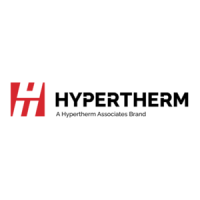Motion Overview 409
Determining Maximum Machine Speed
The following information is used to establish the proper value for determining max machine speed.
Multiply the max RPM of the motor by the number of inches of travel per revolution to get the resulting
Maximum Machine Speed in Inches per Minute.
For example*
4000 RPM Motors x .125 inches per rev = 500 inches per minute
*Note: Through test or calculation it is determined that the table moves 1/8 inches per revolution of
the encoder.
With the Maximum Speed, Encoder Counts per Inch, DAC and Encoder polarities determined and
entered into control setups, a simple test of machine motion can be made in the control Drive
Diagnostics screen. This test should be made with the motors disengaged for safety. This is a basic
motion test of the system and does not use gain terms or the position loop for motion. Please refer to
the Speeds information in this guide for more information on this feature.
3) Gain Term Definitions
Proportional Gain
In a feedback control system the error term is acted on by the control system and it in turn alters the
output. Proportional Gain is pure amplification of the error term. In a closed loop control system this is
proportional to the error signal. Simply put, the output is Proportional Gain times error.
In most systems Proportional Gain is the primary tuning parameter to improve the response of the
position loop.
Integral Gain
Perhaps the best understanding comes from realizing that the limit of Proportional Gain is that it
cannot completely eliminate error. The system can become unstable if only Proportional Gain is used
to try and eliminate all the error in a system. When the response of a system is considered
satisfactory, but steady state error is excessive, the error can be further reduced by increasing
system gain only for long term accumulations of error over time. Integral gain is sometimes used to
compensate for static load disturbances like torque loading, gravity bias, and offset.
NOTE: This term can cause instability in a system as it has a more instant effect at the beginning of a
move profile. Therefore, it is rarely used for velocity type drives. However, it can provide improved
response with current type drives. Only small adjustments to Integral Gain should be made if
indications of steady state error exist. In almost all applications this value is set to zero. We
recommend using the Feed Forward Gain for closing following error occurring during a move profile.
Derivative Gain
Derivative Gain responds to the rate of change of the signal and can produce corrections before the
error term becomes large, therefore it is useful in improving the transient response of a system.
Since it opposes change in the controlled output, it can produce a stabilizing effect by damping a
tendency toward oscillation. This is the reason we promote tuning by following error to the maximum
Proportional Gain then setting Derivative Gain at 10% of Proportional Gain as a rule of thumb. Do not
overdo Derivative Gain as it can have a detrimental effect on the overall response of the system.

